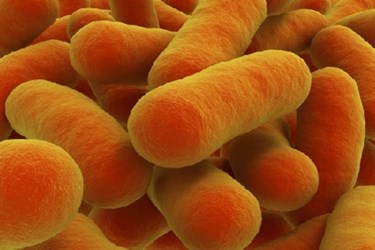Salmonella — The Deadly Truth About Cross-Contamination
By Laurel Maloy, contributing writer, Food Online

Salmonella knows no boundaries. The evidence of cross-contamination is the fact that in all instances of outbreaks, only a small percentage of cases are traced back to the original source —though pathological testing links the outbreak’s specific strains
Strains of Salmonella have been linked to an amazing number of different food products, for both human and animal consumption, as well as to live animals commonly handled by people. Since 2012 the sources of Salmonella infections include:
- small pet turtles
- cucumbers
- live poultry — a May 2014 Salmonella outbreak sickened 300 people in 42 states and Puerto Rico. More than 30 percent required hospitalization for strains of Salmonella Infantis, Salmonella Hadar, or Salmonella Newport. The Center for Disease Control and Prevention’s (CDC) National Antimicrobial Resistance Monitoring System (NARMS) collected isolates from 11 patients infected with Salmonella Infantis or Newport. Two of those patients had antibiotic-resistant (ABR) strains. This latest Salmonella outbreak has attributed 80 percent of the cases to Mt. Healthy Hatcheries. This same hatchery was linked to Salmonella infections in live poultry in 2012 and 2013, sickening a total of 353 people, killing 2 and hospitalizing 63.
- mangoes
- dry dog food
- sprouted chia powder — Last month, a Salmonella outbreak sickened 25 people in 15 states with three requiring hospitalization. The outbreak strains were Salmonella Newport, Salmonella Hartford, and Salmonella Oranienburg. No deaths have been reported and all four isolates collected by NARMS were not ABR.
- hedgehogs
- ground beef
- pet Bearded Dragons — two strains of Salmonella, Cotham, and Kisarawe, sickened 150 people in 35 states, with 43 percent requiring hospitalization. 12 isolates of Salmonella Cotham were tested by NARMS. Only one was found to be ABR, but it was resistant to ceftriaxone, an antibiotic often used to treat severe Salmonella infections.
- chicken eggs
- cheese
- raw chicken — Salmonella Heidelberg sickened 634 people in 29 states and Puerto Rico in an ongoing outbreak linked back to Foster Farms.
- peanut butter
- cantaloupe
- tuna products
- frozen feeder rodents — this May, an outbreak sickened 41 people in 21 states. No deaths were reported, but 16 percent of the patients were hospitalized. The outbreak strain was Salmonella Typhimurium and traced back to physical contact with frozen feeder rodents packaged by Reptile Industries. NARMS did not report any findings, so it is assumed isolates were not collected for testing.
- clinical/college/university teaching microbiology labs
Do you know what university has found a chink in Salmonella’s armor?
The CDC estimates that approximately 1.2 million gastrointestinal illnesses are caused by Salmonella infections every year. Of these, about 23,000 patients are hospitalized, with approximately 450 deaths resulting. This nasty pathogen has been tracked in the U.S. since 1962, data confirming the existence of 32 Salmonella serotypes. It is prolific, it is everywhere, and it continues to be problematic. In fact, within the food processing industry, Salmonella is a fact of life; so much so, the CDC publishes Quick Tips for Preventing Salmonella.
In the highly publicized case of Peanut Corporation of America (PCA), the public is getting quite the education. One principal witness for the prosecution, Sammy Lightsey, the top manager at the plant, painted a picture of ignorance and cover ups. Salmonella-tainted products were knowingly shipped with falsified lab reports. Lightsey testified, “In my mind, I wasn’t intentionally hurting anyone.” Though, nine people lost their lives and 714 were infected, none of the defendants are being charged with murder. They are being charged with obstruction of justice, covering up lab tests, and shipping tainted products. Lightsey is testifying as part of a plea deal to reduce his sentence from 76 years to six.
Food safety experts talk about handling high-risk foods, including peanut butter
Salmonella contamination is legal. The Food Safety Inspection Service (FSIS) actually allows for a certain percentage of Salmonella-tainted products. The reasoning behind it is that proper cooking can kill the microbe, therefore, it is not an adulterant, and therefore, not actionable, according to the law. FSIS allows a 7.5 percent Salmonella contamination rate. This industry standard for poultry processors recently put in place in 2011. The truth is though, the manner in which these guidelines are applied, allows five or fewer positive samples out of 51, thus, a 10 or so percent allowance for contaminated carcasses.
Pressure is being applied in regard to the ABR Salmonella strains, but so far is meeting with resistance. My guess is that salmonella is so prevalent, FSIS may believe it is impossible to control. Could the power to shut down plants when discovering ABR strains of Salmonella actually create a shortage and cause a price surge? This seems possible, especially in the instance of poultry products, easily one of the least expensive and most widely-consumed protein sources.
There is evidently no place that Salmonella cannot reside. This means every effort should be made to avoid cross-contamination. Some of these methods are included in FSMA. The proposed rule on Sanitary Transportation of Human and Animal Food and parts of the law relating to prevention contain language consistent with CDC guidelines for prevention. However, until Salmonella is attacked and regulated, as E. coli has been, the public is at risk. If the public is at risk, your business is at risk.
